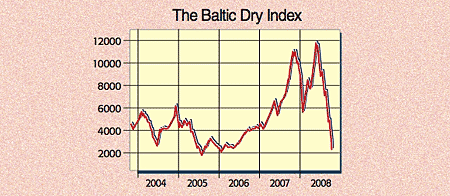
Trade is built on trust – that the goods you pay for will turn up; that the goods you send to market will be paid for. The financial crisis means that trust has now gone. Tim Bennett reports.
What is ‘trade finance’ for?
Trade finance exists thanks to what the Financial Times’s Lex calls “one of the most disruptive technologies ever invented… the humble box”. Two features of our modern economy – globalisation and our reliance on shipping – mean that huge volumes of everything from basic commodities to finished goods travel from sellers in one country to buyers in another in standardised metal containers crammed onto cargo ships. But the fact that a shipment can take days or weeks to arrive raises some problems about payment. How can sellers ensure a buyer will pay on time, or indeed at all, and what do they do for cash in the meantime? A buyer’s potential headaches include whether the right goods will turn up in the right port, and at the right time – clearly they’re not keen to pay up until the goods have arrived intact. Throw in different laws, currencies and time zones, and what looks like a simple deal to ship iron-ore from one country to another could quickly become a nightmare. That’s where trade finance comes in.
Trade finance: how does it work?
In short, a bank or specialist trade finance boutique will take payment risk away for a fee. There are many ‘trade finance’ solutions, most of which have been around since the Middle Ages. The most commonly used is the letter of credit. Drawn up typically for a seller by a bank, the basic letter guarantees payment for goods once they are safely on board a ship, but before they arrive with a buyer. Without it the two parties may not trust each other to honour their side of a deal. There are many variants – for example, a small exporter with cashflow worries may request the bank to pay it cash up front, where payment would otherwise not be due from the buyer for several months. This up-front payment is usually arranged at a ‘discount’. In other words, the bank offers the seller less than the total value of the invoiced goods shipped, confident it can eventually collect the full amount due from the buyer later using the shipment as security (‘collateral’). As such, trade finance, an industry expert tells Bloomberg, is normally “the easiest, cheapest and (being backed by a shipment of goods) most collateralised form of credit”.
Trade finance: is it big business?
Huge. As Jonathan Lynn notes on Reuters, the development of standardised containers and port equipment has “helped spur a 90-fold growth in the annual value of world trade” to around $14 trillion today. According to a trade official quoted in the Lloyds List shipping newspaper, “90% of that is financed in some way by credit”. Individual letters of credit can underwrite some massive shipments – Deutsche Bank for example was recently involved in three shipments for Russian clients, each with a value of above $3bn.
How is trade finance coping with the credit crunch
Badly. Steve Rodley, director of London-based shipping hedge-fund Global Maritime Investments, puts it bluntly: “The whole shipping market has crashed.” The trouble is that credit is the lifeblood of commerce, but it is built entirely on trust. And that has evaporated. As such, many ship owners can’t get banks to issue letters of credit, particularly on cargoes of price-volatile commodities that no longer look like adequate collateral. Even those who can get letters of credit are finding that their counterparties may no longer trust the credit rating of anything other than large, well-established banks, many of which are now charging big premiums. Letters now cost three times the going rate of a year ago, according to Lynn.
How does this affect world trade?
“Nothing is moving because the trader doesn’t want to take the risk of putting cargo on the boat and finding that nobody can pay,” says Khalid Hashim, head of Precious Shipping, in the Lloyds List. The freeze has seen commodity shipping rates plunge to “the lowest in more than five years”, reports Bloomberg. The Baltic Dry Index – a key barometer of global freight activity and therefore world trade – fell 11% in just one day last week (see chart). As a result, grain cargoes have begun piling up in ports in the Americas, reports The Economist. So bad have things got for Brazil that the government plans to use its foreign-exchange reserves to increase credit lines for exporters in a bid to keep trade flowing.
What’s being done about it?
The World Trade Organisation (WTO) has hastily scheduled a meeting of key financial institutions on 12 November specifically to discuss the impact of what the director-general, Pascal Lamy, calls “very difficult conditions in international financial markets” on trade finance. Anxious to be seen to act, ahead of the key meeting the WTO raised its trade finance programme by 50% to $1.5bn. But Lamy wants a global solution, warning that “uncertainty… could fuel protectionism” (see below).
What if these moves fail?
“It’s one more thing in a big negative melting pot” is how one Danish shipping chief executive summarised the trade finance crisis on Bloomberg. The FT agreed, noting that if the November meeting of the WTO fails as comprehensively as July’s world trade talks in Doha, the prospect of Smoot-Hawley-style unilateral action (US legislation in the 1930s that raised US tariffs, slowed global trade and helped turn the crash into a depression) can’t be ruled out. Even if that is avoided, “without trade finance, global commerce will shrink”.